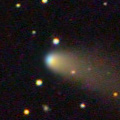
|
Now it is so bright as 9.6 mag (Dec. 29, Maik Meyer). It keeps as bright as 9-10 mag for a long time until spring. It will be observable in good condition for a long time after this in the Northern Hemisphere. It keeps visible visually for one year until 2010 autumn.
Date(TT) R.A. (2000) Decl. Delta r Elong. m1 Best Time(A, h)
Jan. 9 14 2.18 29 3.8 2.254 2.491 92 9.3 5:38 (287, 74)
Jan. 16 14 14.63 31 54.0 2.224 2.525 96 9.4 5:38 (282, 78)
|
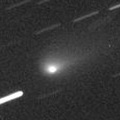
|
Now it is so bright as 10.3 mag (Dec. 29, Maik Meyer). It keeps observable bright as 9-10 mag in a good condition for a long time from winter to spring. It keeps observable until 2010 autumn when it fades down to 16 mag.
Date(TT) R.A. (2000) Decl. Delta r Elong. m1 Best Time(A, h)
Jan. 9 12 27.71 -1 38.9 1.154 1.658 101 10.4 5:14 ( 0, 53)
Jan. 16 12 42.54 -2 48.8 1.088 1.641 104 10.2 5:02 ( 0, 52)
|
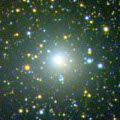
|
It reached up to 7.7 mag in summer (Aug. 13, Chris Wyatt). It is fading now. It has already faded down to 10.2 mag (Dec. 11, Carlos Labordena). Now it is not observable. In the Southern Hemisphere, it will appear in the morning sky in late February, then it keeps observable for a long time. But in the Northern Hemisphere, it is only observable in the low sky in spring, then it will never be observable again.
Date(TT) R.A. (2000) Decl. Delta r Elong. m1 Best Time(A, h)
Jan. 9 19 43.03 -18 52.6 4.578 3.602 6 10.5 18:35 ( 75,-12)
Jan. 16 19 47.41 -19 31.8 4.618 3.635 1 10.6 5:38 (282,-17)
|
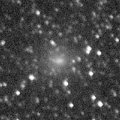
|
It reached up to 8.4 mag in October (Oct. 20, Marco Goiato). Now it is fading. But it is bright as 9.7 mag still now (Dec. 20, Marco Goiato). In the Northern Hemisphere, it keeps observable in the low sky until February when it fades down to 13.5 mag.
Date(TT) R.A. (2000) Decl. Delta r Elong. m1 Best Time(A, h)
Jan. 9 22 10.63 -14 20.9 2.269 1.659 41 11.2 18:35 ( 56, 19)
Jan. 16 22 30.05 -12 23.6 2.346 1.700 39 11.6 18:40 ( 60, 18)
|
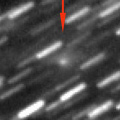
|
It was very bright visually as 9.2 mag (Nov. 18, Juan Jose Gonzalez) and 11.6 mag (Dec. 7, Chris Wyatt) until around the perihelion passage. However, now it is so faint as 16.3 mag (Jan. 5, Hidetaka Sato), and looks almost completely stellar with no coma. In the Southern Hemisphere, it is observable in the excellent condition after January. In the Northern Hemisphere, it is not observable now. But it will appear in the morning sky in late January, then it keeps observable while fading gradually.
Date(TT) R.A. (2000) Decl. Delta r Elong. m1 Best Time(A, h)
Jan. 9 12 45.53 -69 26.8 0.197 0.942 72 11.8 5:37 ( 0,-15)
Jan. 16 10 24.82 -53 47.0 0.198 1.031 98 12.6 2:47 ( 0, 0)
|
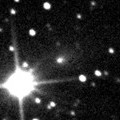
|
Now it is 12.7 mag (Dec. 16, Marco Goiato). It is a bit fainter than expected. In the Northern Hemisphere, it keeps observable in good condition for a long time after this until 2010 spring when it fades out.
Date(TT) R.A. (2000) Decl. Delta r Elong. m1 Best Time(A, h)
Jan. 9 5 44.64 10 10.1 1.053 1.985 154 12.0 22:29 ( 0, 65)
Jan. 16 5 42.34 11 1.1 1.084 1.987 147 12.1 21:59 ( 0, 66)
|
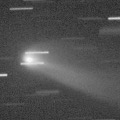
|
An outburst occured on Oct. 13, and it reached up to 8.5 mag on Oct. 15 (Toru Yusa). The central nucleus shined like a bright star, and the dust coma looked like 17P/Holmes in outburst. However, the comet returned to the normal state within a few days. Now it is 12.1 mag (Dec. 18, Marco Goiato). It will fade out rapidly, and will be fainter than 14 mag in late January. In the Northern Hemisphere, it keeps observable in good condition for a long time until spring when it becomes fainter than 18 mag.
Date(TT) R.A. (2000) Decl. Delta r Elong. m1 Best Time(A, h)
Jan. 9 5 33.66 10 43.6 0.984 1.909 152 13.0 22:18 ( 0, 66)
Jan. 16 5 31.54 12 23.2 1.074 1.967 145 13.4 21:48 ( 0, 68)
|
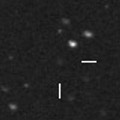
|
It is expected to reach up to 10 mag and to be observable in good condition in spring. Now it is not observable. It will appear in the morning sky at 13 mag in late January.
Date(TT) R.A. (2000) Decl. Delta r Elong. m1 Best Time(A, h)
Jan. 9 17 51.14 -25 22.5 2.988 2.096 20 13.6 5:38 (299, -3)
Jan. 16 17 59.92 -23 31.7 2.872 2.030 25 13.4 5:38 (300, 1)
|

|
Outbursts occured repeatedly since September, and it keeps visible visually. It is bright as 12.0 mag still now (Dec. 12, Juan Jose Gonzalez).
Date(TT) R.A. (2000) Decl. Delta r Elong. m1 Best Time(A, h)
Jan. 9 9 48.96 11 43.5 5.373 6.186 142 13.6 2:36 ( 0, 67)
Jan. 16 9 46.53 11 49.9 5.311 6.188 150 13.6 2:07 ( 0, 67)
|

|
Now it is not observable. It will appear in the morning sky again in 2010 February. It will brighten up to 12-13 mag in 2010 summer. But it locates somewhat low in the Northern Hemisphere.
Date(TT) R.A. (2000) Decl. Delta r Elong. m1 Best Time(A, h)
Jan. 9 17 18.19 -23 15.5 3.286 2.462 28 14.1 5:38 (302, 4)
Jan. 16 17 32.81 -23 44.5 3.237 2.456 31 14.0 5:38 (305, 6)
|
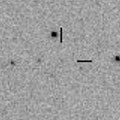
|
Now it is 15.6 mag (Dec. 6, A. Maury, J. B. de Vanssay, F. Mallia, F. Kugel). It will be 14 mag from winter to spring in 2010. But the condition is bad. Now it is not observable in the Northern Hemisphere. But in the Southern Hemisphere, it keeps observable until mid January. In the Northern Hemisphere, it will appear in the morning sky at 15 mag in late May in 2010, then it keeps observable while fading gradually after that.
Date(TT) R.A. (2000) Decl. Delta r Elong. m1 Best Time(A, h)
Jan. 9 21 47.73 -28 4.3 2.512 1.781 33 14.3 18:35 ( 50, 5)
Jan. 16 22 2.61 -24 41.7 2.536 1.762 30 14.2 18:40 ( 56, 4)
|
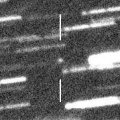
|
It is expected to be bright as 9-10 mag in the northern sky in March and April. It must have been observable in the morning sky until mid December. However, few observations have been reported since October. Now it is not observable. It will appear in the morning sky at 13.5 mag in late January, then it will brighten rapidly. In the Southern Hemisphere, it will be observable in the low sky after the perihelion passage only.
Date(TT) R.A. (2000) Decl. Delta r Elong. m1 Best Time(A, h)
Jan. 9 19 25.92 0 6.4 2.409 1.545 22 14.8 18:35 ( 94, -5)
Jan. 16 19 32.86 1 47.8 2.294 1.443 23 14.4 5:38 (267, -2)
|

|
It brightened up to 11 mag in spring and summer in 2009. Now it is not observable. It will be observable again in the morning sky after late January. But it locates somewhat low in the Northern Hemisphere.
Date(TT) R.A. (2000) Decl. Delta r Elong. m1 Best Time(A, h)
Jan. 9 17 24.26 -25 16.7 3.324 2.485 26 14.6 5:38 (303, 2)
Jan. 16 17 38.42 -25 31.6 3.304 2.507 30 14.6 5:38 (305, 4)
|
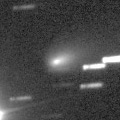
|
It has brightened much faster than expected. Now it is so bright as 11.8 mag (Dec. 12, Juan Jose Gonzalez). It will be fading after January. It keeps observable in good condition for a long time. But it may fade out very rapidly.
Date(TT) R.A. (2000) Decl. Delta r Elong. m1 Best Time(A, h)
Jan. 9 10 35.40 8 11.6 0.583 1.436 131 14.6 3:22 ( 0, 63)
Jan. 16 10 39.61 10 12.5 0.581 1.467 137 15.0 2:59 ( 0, 65)
|
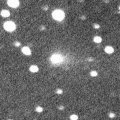
|
Now it is 13.4 mag, already visible visually (Dec. 24, Marco Goiato). It will be observable at 15 mag in good condition in winter and spring.
Date(TT) R.A. (2000) Decl. Delta r Elong. m1 Best Time(A, h)
Jan. 9 4 52.26 15 17.4 1.198 2.078 144 15.0 21:36 ( 0, 70)
Jan. 16 4 49.96 16 0.9 1.221 2.054 137 15.0 21:07 ( 0, 71)
|

|
It brightned up to 10 mag from late 2008 to early 2009. Now it is fading. But it is still bright as 16.0 mag (Dec. 1, Ken-ichi Kadota). It will be observable in good condition again in winter at 15-16 mag. Then it may be still visible visually.
Date(TT) R.A. (2000) Decl. Delta r Elong. m1 Best Time(A, h)
Jan. 9 10 21.10 3 28.4 4.658 5.369 132 15.3 3:08 ( 0, 58)
Jan. 16 10 18.09 3 20.1 4.634 5.424 139 15.3 2:38 ( 0, 58)
|
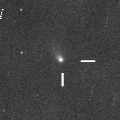
|
New periodic comet, brightened very rapidly. Now it is 14.8 mag and visible visually (Dec. 4, Juan Jose Gonzalez). It is observable at 15 mag in good condition in winter.
Date(TT) R.A. (2000) Decl. Delta r Elong. m1 Best Time(A, h)
Jan. 9 2 27.10 -7 48.6 1.259 1.755 102 15.3 19:12 ( 0, 47)
Jan. 16 2 38.74 -8 1.0 1.319 1.755 98 15.4 18:57 ( 0, 47)
|

|
It will pass the perihelion in late December. It will brighten very rapidly near by the perihelion. However, the condition is very bad in this apparition. Extremely hard to recover.
Date(TT) R.A. (2000) Decl. Delta r Elong. m1 Best Time(A, h)
Jan. 9 20 56.21 -19 56.8 1.661 0.842 22 15.4 18:35 ( 64, 2)
Jan. 16 21 34.56 -17 25.5 1.660 0.871 24 15.7 18:40 ( 65, 4)
|
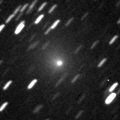
|
It brightened up to 8.5 mag in May and June (May 26, Juan Jose Gonzalez). Now it is fading. It was still bright as 11.6 mag in October (Oct. 10, Marco Goiato). However, it is already too faint to see visually. It will never be observable again in the Northern Hemisphere. In the Southern Hemisphere, it will be low temporarily in winter, but it keeps observable until when it fades out.
Date(TT) R.A. (2000) Decl. Delta r Elong. m1 Best Time(A, h)
Jan. 9 19 22.65 -47 37.0 3.980 3.121 25 15.4 18:35 ( 50,-29)
Jan. 16 19 35.29 -46 49.3 4.052 3.197 25 15.6 5:38 (310,-27)
|
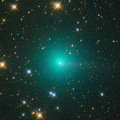
|
It brightened up to 6.7 mag in June (June 9, Marco Goiato). Now it is 14.2 mag (Dec. 14, Ken-ichi Kadota), a bit brighter than this ephemeris. It must be visible visually still now. It will be fading after this, and keeps observable until next spring when it becomes fainter than 18 mag.
Date(TT) R.A. (2000) Decl. Delta r Elong. m1 Best Time(A, h)
Jan. 9 13 38.29 30 11.4 2.729 3.015 97 15.5 5:38 (293, 79)
Jan. 16 13 34.05 33 23.4 2.678 3.077 104 15.8 5:38 (297, 86)
|
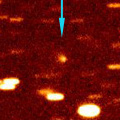
|
It had been brightening as expected until Dec. 29 when it was 16.4 mag (Ken-ichi Kadota). However, it was reported bright as 14.2 mag on Jan. 3 (W. Hasubick). Maybe an outburst. The condition of this apparition is bad. It will reach up to 11-12 mag from spring to autumn in 2010, but it is not observable. It will be getting brighter gradually in the evening sky, but it will be too low to observe in January at 15 mag.
Date(TT) R.A. (2000) Decl. Delta r Elong. m1 Best Time(A, h)
Jan. 9 21 53.01 0 19.3 2.851 2.243 43 15.7 18:35 ( 71, 25)
Jan. 16 22 5.27 1 4.2 2.859 2.194 39 15.6 18:40 ( 76, 22)
|
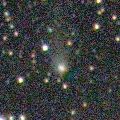
|
It brightened up to 11.5 mag in 2008 summer (Aug. 4, Marco Goiato). Now it is 15.8 mag (Dec. 18, A. Novichonok, A. Smirnov, S. Plaksa). It keeps observable in good condition for a long time in the Southern Hemisphere. Now it became observable again also in the Northern Hemisphere. It will keep 15-16 mag until next spring.
Date(TT) R.A. (2000) Decl. Delta r Elong. m1 Best Time(A, h)
Jan. 9 4 54.17 -36 30.4 4.445 4.898 111 15.6 21:38 ( 0, 19)
Jan. 16 4 48.55 -34 58.0 4.537 4.951 109 15.7 21:05 ( 0, 20)
|
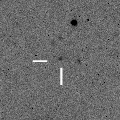
|
Now it is 16.8 mag (Dec. 20, J. M. Trigo-Rodriguez). It is expected to brighten rapidly and to be observable at 15 mag in good condition from winter to spring. However, it is a bit fainter than this ephemeris recently.
Date(TT) R.A. (2000) Decl. Delta r Elong. m1 Best Time(A, h)
Jan. 9 10 39.99 17 41.6 1.521 2.306 132 15.8 3:27 ( 0, 73)
Jan. 16 10 40.97 18 8.5 1.455 2.296 139 15.6 3:01 ( 0, 73)
|
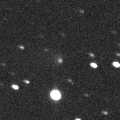
|
Now it is 16.4 mag (Nov. 3, Ken-ichi Kadota). It will reach up to 12 mag in 2012, and will be observable visually at 12-13 mag for a long time from 2011 to 2013. In 2009, it is observable in good condition at 16 mag from summer to autumn. In the Northern Hemisphere, the comet will be low around its brightest seasons.
Date(TT) R.A. (2000) Decl. Delta r Elong. m1 Best Time(A, h)
Jan. 9 21 40.53 -1 26.6 8.636 7.908 39 15.7 18:35 ( 72, 21)
Jan. 16 21 41.85 -1 24.3 8.673 7.872 33 15.7 18:40 ( 77, 15)
|
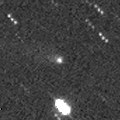
|
Now it is 16.8 mag (Dec. 18, Ken-ichi Kadota), a bit fainter than this ephemeris. It will be observable at 16 mag in good condition until spring.
Date(TT) R.A. (2000) Decl. Delta r Elong. m1 Best Time(A, h)
Jan. 9 15 43.26 20 55.3 3.206 2.984 68 15.8 5:38 (279, 50)
Jan. 16 15 41.52 21 17.3 3.129 3.010 74 15.8 5:38 (284, 56)
|
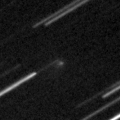
|
Now it is 15.7 mag (Dec. 27, Yasukazu Ikari). It will be observable at 15.5 mag in the evening sky until spring.
Date(TT) R.A. (2000) Decl. Delta r Elong. m1 Best Time(A, h)
Jan. 9 1 2.93 38 48.5 1.253 1.728 100 15.9 18:35 (116, 80)
Jan. 16 0 56.55 40 40.0 1.289 1.675 93 15.8 18:40 (115, 72)
|
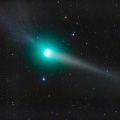
|
It passed near by the earth in late February in 2009, and it reached up to 4.9 mag (Feb. 23, Juan Jose Gonzalez). Now it is 16.2 mag (Dec. 22, R. Garcia). It will be low in the evening sky at 17-18 mag in 2010 spring.
Date(TT) R.A. (2000) Decl. Delta r Elong. m1 Best Time(A, h)
Jan. 9 5 1.83 20 49.5 3.825 4.688 147 15.8 21:45 ( 0, 76)
Jan. 16 4 53.71 20 39.6 3.970 4.755 138 15.9 21:10 ( 0, 76)
|

|
Now it is 16.6 mag (Dec. 5, Ken-ichi Kadota). It was observed as 15-16 mag in early 2009. In 2010, it will be observable at 16 mag in good condition from winter to spring.
Date(TT) R.A. (2000) Decl. Delta r Elong. m1 Best Time(A, h)
Jan. 9 13 44.13 -4 10.9 3.590 3.602 82 15.9 5:38 (340, 49)
Jan. 16 13 48.75 -4 28.9 3.491 3.606 88 15.9 5:38 (348, 50)
|

|
It brightened up to 13 mag and observed visually from 2007 to 2009. Due to the far distance, it is bright as 15.7 mag still now (Dec. 28, P. C. Sherrod). It will be observable in good condition again until spring.
Date(TT) R.A. (2000) Decl. Delta r Elong. m1 Best Time(A, h)
Jan. 9 13 25.88 34 17.1 7.322 7.574 101 16.1 5:38 (274, 83)
Jan. 16 13 23.91 35 5.2 7.258 7.605 107 16.1 5:38 (269, 89)
|
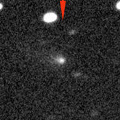
|
It brightened up to 11 mag in outburst in 2003. However, it does not seem to be so bright in this apparition. Now it is 16.2 mag (Dec. 26, Ken-ichi Kadota). It will be observable in good condition in winter. But it seems to brighten only up to 16 mag.
Date(TT) R.A. (2000) Decl. Delta r Elong. m1 Best Time(A, h)
Jan. 9 0 37.64 13 2.0 1.139 1.443 85 16.2 18:35 ( 41, 63)
Jan. 16 0 55.05 14 8.5 1.157 1.419 82 16.1 18:40 ( 49, 61)
|
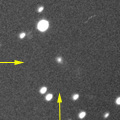
|
Appearing in the morning sky. It will be observable at 15 mag for a long time in 2010.
Date(TT) R.A. (2000) Decl. Delta r Elong. m1 Best Time(A, h)
Jan. 9 16 59.69 10 43.1 5.593 4.983 47 16.2 5:38 (277, 29)
Jan. 16 17 6.34 11 29.9 5.508 4.960 51 16.2 5:38 (280, 34)
|
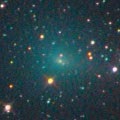
|
It brightened up to 8.8 mag in May and June (May 19, Juan Jose Gonzalez). It has already faded down to 15.7 mag (Dec. 23, Ken-ichi Kadota). It keeps observable in the evening sky for a long time until next spring when it becomes fainter than 18 mag.
Date(TT) R.A. (2000) Decl. Delta r Elong. m1 Best Time(A, h)
Jan. 9 0 4.06 -4 20.4 2.749 2.597 70 16.2 18:35 ( 38, 44)
Jan. 16 0 13.36 -3 12.9 2.877 2.639 66 16.4 18:40 ( 45, 41)
|
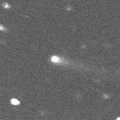
|
Now it is 15.9 mag (Dec. 18, Ken-ichi Kadota). This comet tends to brighten after the perihelion passage. It will be observable at 16 mag in 2010 and 2011. It is brighter than this ephemeris recently.
Date(TT) R.A. (2000) Decl. Delta r Elong. m1 Best Time(A, h)
Jan. 9 4 21.07 23 36.2 2.379 3.186 138 16.8 21:05 ( 0, 79)
Jan. 16 4 19.93 23 25.1 2.446 3.185 131 16.8 20:37 ( 0, 78)
|
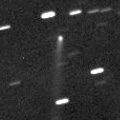
|
Now it is 16.9 mag (Dec. 22, Toru Yusa). It has a very long tail in spite of the distance. It passed the perihelion in 2009, but it was brighter in 2008. It will be fading after this, and will be fainter than 18 mag in next spring.
Date(TT) R.A. (2000) Decl. Delta r Elong. m1 Best Time(A, h)
Jan. 9 23 4.25 32 56.8 4.279 4.166 76 17.0 18:35 ( 99, 56)
Jan. 16 23 8.23 33 30.5 4.384 4.188 72 17.1 18:40 (102, 50)
|
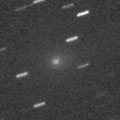
|
Fading slowly. Now it is 16.9 mag (Dec. 23, Ken-ichi Kadota). It keeps observable in good condition until February when it becomes fainter than 18 mag.
Date(TT) R.A. (2000) Decl. Delta r Elong. m1 Best Time(A, h)
Jan. 9 10 8.59 7 38.6 1.831 2.636 136 17.1 2:56 ( 0, 63)
Jan. 16 10 3.12 7 42.3 1.822 2.690 145 17.2 2:23 ( 0, 63)
|
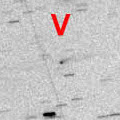
|
Now it is 17.9 mag (Dec. 5, Ken-ichi Kadota). It will be fainter than 18 mag in March.
Date(TT) R.A. (2000) Decl. Delta r Elong. m1 Best Time(A, h)
Jan. 9 11 14.87 16 28.6 1.402 2.121 124 17.2 4:02 ( 0, 71)
Jan. 16 11 14.68 17 48.0 1.381 2.165 131 17.3 3:34 ( 0, 73)
|

|
It passed the perihelion in September, and brightened up to 14.6 mag (Sept. 19, Hidetaka Sato). It is fading now, but still bright as 16.5 mag (Dec. 20, J. M. Aymami). It keeps observable in good condition until February when it becomes fainter than 18 mag.
Date(TT) R.A. (2000) Decl. Delta r Elong. m1 Best Time(A, h)
Jan. 9 23 17.94 15 50.2 2.037 1.928 69 17.2 18:35 ( 70, 51)
Jan. 16 23 31.71 17 48.5 2.159 1.987 66 17.4 18:40 ( 77, 49)
|
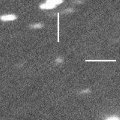
|
Now it is 18.0 mag (Dec. 19, Ken-ichi Kadota). It keeps observable at 17 mag for a long time from 2010 to 2012.
Date(TT) R.A. (2000) Decl. Delta r Elong. m1 Best Time(A, h)
Jan. 9 2 23.99 17 30.9 8.196 8.596 110 17.4 19:09 ( 0, 73)
Jan. 16 2 21.38 17 22.5 8.304 8.581 103 17.4 18:40 ( 2, 72)
|
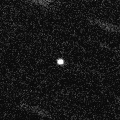
|
The condition is good in this apparition. It approached to the earth down to 0.38 A.U., and brightened up to 15.9 mag (Nov. 24, A. Sanchez). Now it is fading. It has already faded down to 16.7 mag (Dec. 14, Katsumi Yoshimoto). It will be fainter than 18 mag in mid January.
Date(TT) R.A. (2000) Decl. Delta r Elong. m1 Best Time(A, h)
Jan. 9 2 23.63 15 22.6 0.737 1.418 110 17.7 19:10 ( 0, 71)
Jan. 16 2 46.58 16 43.0 0.829 1.476 108 18.0 19:05 ( 0, 72)
|

|
Now it is 18.4 mag (Dec. 18, Yasukazu Ikari). It will be observable at 17.5 mag in good condition in early 2010 and early 2011.
Date(TT) R.A. (2000) Decl. Delta r Elong. m1 Best Time(A, h)
Jan. 9 5 24.44 20 34.1 2.678 3.583 153 17.7 22:08 ( 0, 76)
Jan. 16 5 20.85 20 40.0 2.723 3.575 145 17.7 21:37 ( 0, 76)
|

|
Now it is 17.7 mag (Dec. 21, Ken-ichi Kadota). It will be observable at 17.5 mag in good condition in winter.
Date(TT) R.A. (2000) Decl. Delta r Elong. m1 Best Time(A, h)
Jan. 9 10 4.01 32 57.6 2.199 3.037 142 17.8 2:51 ( 0, 88)
Jan. 16 10 1.40 33 44.7 2.163 3.045 148 17.8 2:21 ( 0, 89)
|

|
New periodic comet which brightened up to 14 mag in 2004 and 2005. It should be observable at 18 mag also around the aphelion. However, no observations have been reported since 2008 January. It seems to have faded out rapidly. Now it is fainter than 20.4 mag actually (Sept. 16, Leonid Elenin).
Date(TT) R.A. (2000) Decl. Delta r Elong. m1 Best Time(A, h)
Jan. 9 6 39.06 30 38.1 4.006 4.971 167 20.0 23:23 ( 0, 86)
Jan. 16 6 34.17 30 49.5 4.025 4.963 160 20.0 22:50 ( 0, 86)
|
|
![]()
 C/2008 T2 ( Cardinal )
C/2008 T2 ( Cardinal ) C/2008 Q3 ( Garradd )
C/2008 Q3 ( Garradd ) 43P/Wolf-Harrington
43P/Wolf-Harrington C/2007 G1 ( LINEAR )
C/2007 G1 ( LINEAR ) 94P/Russell 4
94P/Russell 4 C/2006 S3 ( LONEOS )
C/2006 S3 ( LONEOS ) C/2008 N1 ( Holmes )
C/2008 N1 ( Holmes ) C/2009 U3 ( Hill )
C/2009 U3 ( Hill ) C/2007 N3 ( Lulin )
C/2007 N3 ( Lulin ) 74P/Smirnova-Chernykh
74P/Smirnova-Chernykh C/2005 L3 ( McNaught )
C/2005 L3 ( McNaught ) 157P/Tritton
157P/Tritton C/2008 FK75 ( Lemmon-Siding Spring )
C/2008 FK75 ( Lemmon-Siding Spring ) 22P/Kopff
22P/Kopff 203P/2008 R4 ( Korlevic )
203P/2008 R4 ( Korlevic ) C/2008 P1 ( Garradd )
C/2008 P1 ( Garradd ) 64P/Swift-Gehrels
64P/Swift-Gehrels 230P/2009 U6 ( LINEAR )
230P/2009 U6 ( LINEAR ) (3552) Don Quixote
(3552) Don Quixote C/2008 S3 ( Boattini )
C/2008 S3 ( Boattini ) 107P/(4015) Wilson-Harrington
107P/(4015) Wilson-Harrington 31P/Schwassmann-Wachmann 2
31P/Schwassmann-Wachmann 2 232P/2009 W1 ( Hill )
232P/2009 W1 ( Hill ) P/2004 F3 ( NEAT )
P/2004 F3 ( NEAT )![]()




































